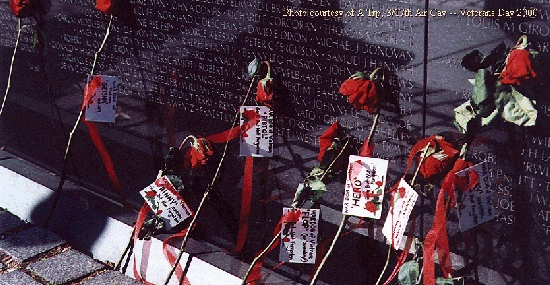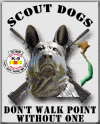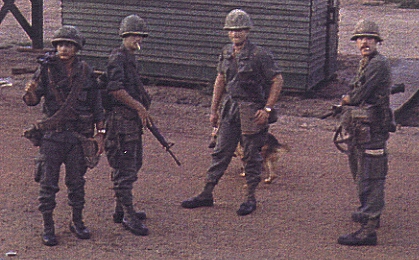Let Us Remember Our
Forgotten Heroes

War Dogs Remembered at the Wall
Veterans Day 2000
Photo courtesy of The Northwest Veterans Newsletter and the Silver Spurs
Roses placed by Sheri Bowen at request of the Dog Handlers
Help Honor K-9 Valor
The Vietnam Dog Handler Association, a veterans group, is spearheading the drive to honor America's war dogs with a national memorial. To learn more or to make a donation, visit http://vdha.us/ on the Web; you can also write to the National War Dog Memorial Fund, c/o Vietnam Dog Handler Association, P.O. Box 5658, Dept. P, Oceanside, Calif. 92052-5658.

Graphic courtesy of the Vietnam Dog Handler Assoc.
* * * * *
The Seattle Times - Parade Magazine - Sunday, April 1, 2001
"They Were Heroes Too" by Richard Ben Cramer
After more than a half-century of service--despite a record of documented heroism and American lives saved--one group of U.S. veterans has been accorded no honor in our nation's capital.
Thousands of dogs who served with the Army, Air Force, Navy, Marines and Coast Guard have been denied a monument in Washington, D.C. Last year, their fellow veterans sought permission to commemorate their service with a single tree at Arlington National Cemetery. That request was denied. Most Americans know nothing of the record of their war dogs--to say nothing of the final chapter of their saga, which some consider a stain on the honor of the U.S. armed forces.
Like so many great American stories, the history of our war dogs began with a small act of rebellion. In World War I, the British, Belgian, Italian and French armies trained thousands of dogs as sentries and messengers or to find and comfort wounded men on the battlefield. On the other side, the Germans deployed 7000 dogs, with thousands more in reserve. (The famous Rin Tin Tin was a German dog found in a trench after an attack.) But the U.S. Army had no such program.
Nevertheless, a small, stray bull terrier named Stubby was adopted by the 102nd Infantry and smuggled aboard a troop ship to France. There, he would prove his mettle.
Stubby carried messages under fire, sought out the wounded and stayed with them until help arrived. One night in February 1918, he roused a sleeping sergeant to warn of a gas attack, giving soldiers time to don masks. On sentry duty, he clamped his teeth into a German infiltrator, who was then captured. In no-man's-land he was wounded by shrapnel but recovered to join the 102nd in battles at Chateau Thierry, The Marne and the Meuse-Argonne. The men of the 102nd hung a Victory Medal from his collar. French women fashioned a blanket for "The Hero Dog" to wear, and with each offensive, more medals were pinned to Stubby's cloak.
After 17 battles, Stubby sailed back to America, where his victorious commander, Gen. John "Black Jack" Pershing, awarded the dog a special gold medal. As a life member of both the American Legion and the Red Cross, Stubby marched in parades across the country and met Presidents Wilson, Harding and Coolidge. When old age felled the warrior in 1926, his body was preserved and displayed for 30 years at the Red Cross Museum in Washington, D.C. But time wore away at his skin, his fur and the memory of his countrymen: Stubby moldered thereafter in a packing crate in a Smithsonian storeroom. Still, his legacy endured in the thousands of lives saved by dogs in subsequent American wars.
Within a month after the attack on Pearl Harbor in December 1941, American's canine trainers had established DFD--Dogs for Defense-- and soon began to work with the Coast Guard (saboteurs were expected to surface from submarines at any moment). By April 1942, dogs were serving as sentries at Army depots and defense plants. That summer, Secretary of War Henry Stimson directed all branches of the service to explore the use of dogs, and the rush was on--for dogs to work as guards, medics, MPs, mine-sniffers, scouts, messengers, even tactical fighters; for dogs to walk patrol in Pacific jungles and mush supplies across Arctic ice. One year after America went to war, the military announced that the Army, Navy, Marines and Coast Guard would need about 125,000 dogs.
Canine combatants were recruited just as men were. But no draft was required. Tens of thousands of dogs were shipped voluntarily to DFD centers, where they were measured, evaluated, examined and trained for duty. A few owners may have fobbed off bad pets, but most were patriots who sent a dog off to war just as they would a son. (That spirit posed an unexpected problem. Mail poured in, asking for news of K-9 recruits--or bearing cards, biscuits or bones.)
The only news the owners could get came from handlers in the field and occasionally in newspaper stories. One such story concerned Chips, a mixed-breed donated from Pleasantville, N.Y., and shipped overseas with the 30th Infantry. With his handler, Pvt. John P. Rowell, Chips took part in the July 1943 invasion of Sicily. Near Licata, on the island's southern coast, Rowell and Chips worked inland in the light before dawn. About 300 yards from the beach, a machine gun disguised with thatch opened fire on Rowell. Chips broke free and streaked for the gunners' pillbox. Soon, an Italian soldier emerged, with Chips biting at his arms and throat. Three more Italian soldiers followed with hands up. Chips suffered a scalp wound and powder burns--proof that the Italians had tried to kill him--but the dog prevailed. After being treated and returned to duty that same night, Chips discovered 10 Italian soldiers approaching on a road. Rowell and his comrades took them all as prisoners--and Chips became a hero.
Chips was awarded the Silver Star for valor and a Purple Heart for his wounds. U.S. papers exulted: Yank Hero Dog Takes 14 Italos! Then the trouble began. The commander of the Order of the Purple Heart complained to President Roosevelt that bestowing the medal on a dog demeaned all the men who had received Purple Hearts. Both of Chips' medals were revoked, and no U.S. war dog would ever again win official decoration.
The only recognition Chips could keep, when he was returned to the States and his owner, was his honorable discharge. Still, that was better than dogs in later wars. When the Pentagon learned how much trouble it took to retrain a dog for civilian life, there would be no more discharges. After 1946, any dog who "enlisted" was a war dog for life.
By the time American soldiers scrambled to save South Korea in 1950, the World Wars' canine lessons had been forgotten. The entire U.S. military had only one platoon of true war dogs--the Army's 26th Scout Dog Platoon, which shipped out in June 1951 and compiled a record of distinction. The fear the animals created among Chinese and North Korean troops was evidenced by the propaganda they blared through loudspeakers at night: "Yankee! Take your dog and go home!"
The war dogs and their handlers spent almost two years in Korea, patrolling at night, when no other unit could match their success. As cease-fire negotiations began, the Army recognized that the dogs' "unbroken record of faithful and gallant performance…saved countless casualties." Still, by the time the last dog came home from Korea, nuclear war was the big threat. The last training center, at Fort Carson, Colo., was shut down in 1957, and the Army abandoned war dogs.
Vietnam changed all that. As the war escalated in the 1960s, first the Air Force and then the Army employed hundreds of canine sentries to guard against Viet Cong infiltration. Marine and Army scout dogs led patrols through jungles, rice paddies and piedmont hills. Once American troops discovered that they seldom lost a man while a dog walked along, there were never enough of the animals. Eventually, 4000 war dogs would serve and protect our troops.
"When we were sick, they would comfort us, and when we were injured, they protected us," said a former Vietnam dog handler, Tom Mitchell of San Diego. "They didn't care how much money we had or what color our skin was. Heck, they didn't even care if we were good soldiers. They loved us unconditionally. And we loved them. Still do."
Stories of the bond between human and canine soldiers are told on Web sites devoted to the war dogs. Along with the animals' heroics, the sites have another theme in common: outrage at the fate of those dogs who laid down their lives for American troops.
When the U.S. pulled out of Vietnam, the Pentagon considered dogs "war equipment"--and ordered them "abandoned in place." As Michael Lemish, official historian for the Vietnam Dog Handler Association (VDHA), notes: "Officially, no one knows what happened to them--the only questions that really remain are how many were killed, eaten or just simply starved to death."
The shame of that chapter in the war dogs' history fuels the drive for recognition--a drive that is picking up steam. In 1999, a documentary about war dogs aired on the Discovery Channel. The first unofficial U.S. memorial was a sculpture unveiled last February at March Field Air Museum in Riverside, Calif. An identical sculpture--man and dog on patrol--was dedicated in October at Georgia's Fort Benning Infantry Museum. And a new photo book about war dogs is being produced by Open Books of Annapolis, Md.

Dog Handlers worked with the Spur Rifle Platoon (1)
Photo Courtesy of Bill Barber - CSM (Ret.)
Spur Rifle Platoon Sergeant
But as yet there is no memorial that will serve for the nation, as the war dogs did.
Veteran dog handlers collected 100,000 signatures but were turned down for a postage stamp. (Bug Bunny made it--the war dogs did not.) The Smithsonian is now renovating the National Museum of American History, but there are no plans to mention war dogs in the new Armed Forces History Hall. (They even sent Stubby packing to a National Guard armory in Connecticut.) And when the veteran dog handlers applied to plant a tree at Arlington National Cemetery, they were denied. Says John Burnam, the president of the VDHA: "We wanted it to be a team memorial--for the war dogs and the men who served with them. But they just won't do it. The bias is simply 'Humans Only.' The didn't want to let us inside the gate or anywhere near it."
-------------------
Pulitzer Prize-winning journalist Richard Ben Cramer is the author of the best-selling biography "Joe DiMaggio: The Hero's Life" (Simon & Schuster). [--END OF ARTICLE--] (emphasis added)
----------------------------------
Footnote:
Parade article transcribed by Pam Young, of The Northwest Veterans Newsletter
as a public service message.
Other resources:
A Guide to Military & War Dogs by Jack Russell